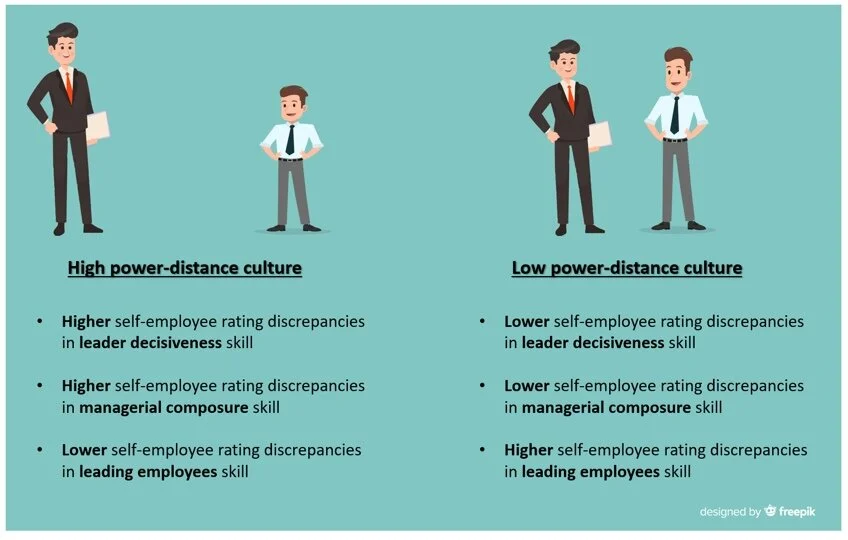Digest 26. Not seeing eye to eye on leadership skills: Culture may explain the differences!
Leaders play crucial roles in moving employees –and organizations– forward especially in the current fast-changing environment. This explains the centrality of leadership development initiatives for businesses, which seem to spend a global annual budget of over $50 billion on leadership development and training (Deloitte, 2020). Developmental feedback in the form of 360-degree evaluations is one of such initiatives. 360-degree feedback comes from various raters (see Digest 22 for more) and provides leaders with a sense of how they are perceived by others. Often, there are discrepancies between one’s own evaluations and the evaluations done by others, which have typically been explained with the leaders’ inaccurate self-perceptions and lack of self-awareness or soft skills. However, such differences could be induced by other factors, which are systemic and external to the leaders themselves, such as cultural influences. Cultural differences also exist in performance management systems, about which you can read more in Digest 12.
How does culture influence self-observer rating discrepancies?
Eckert and her colleagues (2010) looked at how culture can lead to self-observer rating discrepancies on leadership skills. They focused on the exemplary cultural dimension of power distance, which refers to the extent to which people of a certain culture accept and endorse power differences, authority, and status privilege. Among leadership skills, they selected: 1) leaders’ decisiveness, which is related to the decision making style of the leaders whether they are autonomous/autocratic or participative; 2) leaders’ style in leading employees, whether it leans towards top-down supervision or bidirectional exchanges with followers; and 3) managerial composure, which indicates the leader’s ability to maintain calmness and control emotions in times of crisis. To see how power distance influences self-observer rating discrepancies on the three skills, Eckert and colleagues (2010) used data from the BENCHMARKS assessment tool, which is used in 360-degree feedback exercises and collects the 360-degree evaluations. They selected the self-ratings from the managers on this tool as well as the ratings of their observers (one boss, at least three employees, and at least three peers) on the same tool. This resulted in a sample of 4019 managers from 31 countries. Managers and observers came from the same culture.
Their analyses show that culture –more specifically power distance- impacts the self-observer rating discrepancies, based on the opportunities the observer has to interact with the leader, which, in turn, depend on their relationship. This cultural dimension revealed a significant discrepancy between leader (self-) and employees’ ratings, not with other observers’ ratings. In details, the discrepancy in evaluating managerial decisiveness and composure was higher in cultures with high power distance than in countries low on this dimension. Regarding decisiveness, leaders in high power distance cultures are less likely to include employees in their decision-making process, giving them little opportunity to observe how they make decisions and, therefore, to form realistic evaluations. Moreover, managers in high power distance cultures show less emotions and establish more formal and distant relationships with their employees based on their social roles and status in the organization; this may result in more misaligned perceptions of managerial composure.
The results of this study also indicate that the discrepancy between leader (self-) and employee ratings on the ‘leading employees’ skill was lower in high power distance cultures in comparison to low power distance ones. This may sound counter-intuitive as managers in high power distance cultures create less strong relationships with their employees and receive less bottom-up feedback, which could increase –rather than decrease– self-observer rating discrepancies.
Organizational implications
Below is some food for thought for organizations when it comes to interpreting differences in 360-degree ratings:
When receiving incongruent self- and observer ratings in 360-degree evaluations, managers might face negative outcomes for their career path since organizations may consider such incongruencies negatively as, for example, a sign of the manager’s lack of self-awareness. However, these dissimilarities can also depend on contextual factors, such as culture. Therefore, organizations should take cultural values into consideration when dealing with rating discrepancies in 360-degree feedback.
In multinational and cross-cultural organizations, coaches may be paramount to help managers interpreting their 360-degree evaluations and making sense of any discrepancies, and to offer culture-based advices to cross-cultural leaders.
——
Reference: Eckert, R., Ekelund, B. Z., Gentry, W. A., & Dawson, J. F. 2010. “I don’t see me like you see me, but is that a problem?” Cultural influences on rating discrepancy in 360-degree feedback instruments. European Journal of Work and Organizational Psychology, 19(3): 259–278. https://doi.org/10.1080/13594320802678414

